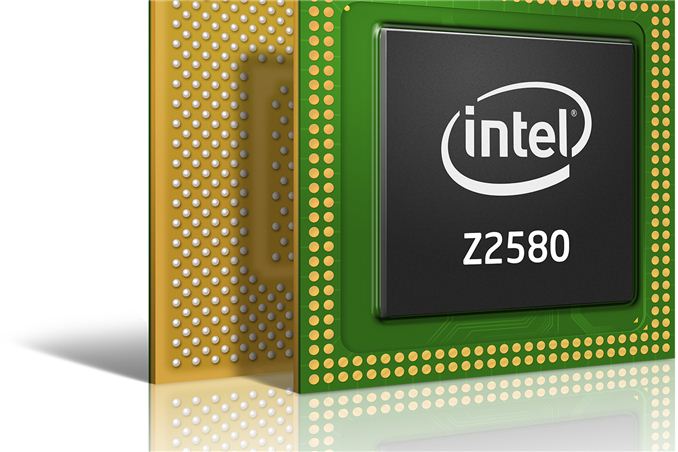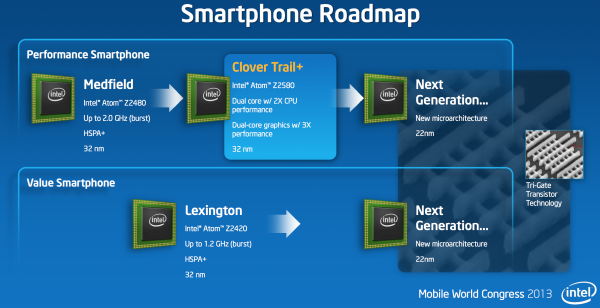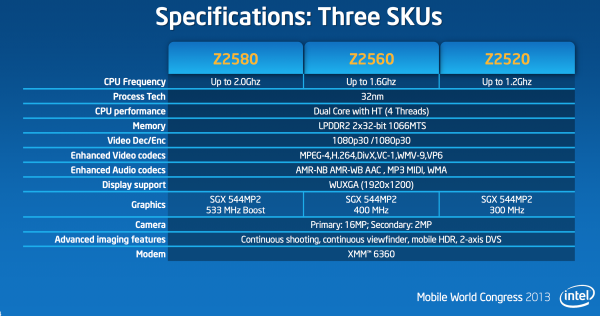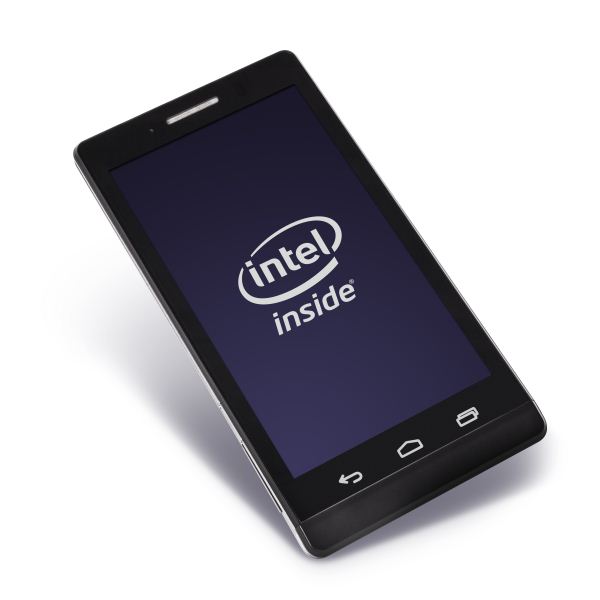Intel's Clover Trail+: Dual-Core CPU and Graphics Unveiled at MWC 2013
by Anand Lal Shimpi on February 25, 2013 12:00 AM EST- Posted in
- SoCs
- Intel
- Atom
- Trade Shows
- Clover Trail+
- MWC 2013

We find ourselves at another Mobile World Congress, discussing another Intel Atom based smartphone SoC. While last year we were talking about faster and lower performing versions of the Medfield family, this year there’s a new topic for discussion: Clover Trail+.
Here’s where Intel’s codenames start getting a bit confusing. Medfield was the original 32nm Atom SoC for smartphones, while Clover Trail was the 32nm platform for Windows 8 tablets. Clover Trail+ is still a 32nm Atom based SoC but it can be used in phones and tablets.
Architecturally, Clover Trail+ takes the Medfield platform, adds a second CPU core (and leaves Hyper Threading enabled), dramatically improves GPU performance and introduces the same memory controller enhancements that were present in the original Clover Trail. Compared to Clover Trail, CT+ mostly adds improved graphics performance.
Intel Goes Dual-Core
On the CPU side we’re still talking about 32nm 2-wide in-order Atom cores, with two threads per core (4 threads total per chip). This is still a direct descendent of the original 45nm Atom core that first debuted in 2008. Intel is quick to point out that the redesigned 22nm architecture is still on track for an introduction (in tablets) this holiday season, but for now we’re still stuck with the old core.
That’s not to say that 32nm Atom isn’t competitive. As we’ve already shown, from a performance standpoint the 5 year old Atom architecture is still faster than everything but ARM’s Cortex A15. Qualcomm’s 28nm Krait architecture is lower power, but Intel is at least competitive.
Frequencies vary depending on the SKU you’re talking about. Just like with Medfield, there are three CT+ SKUs: the Atom Z2580, Z2560 and Z2520. Compared to the previous generation the second digit has been incremented by one indicating that CT+ is obviously newer/better.
All three SKUs feature two cores, but what changes is their max CPU and GPU clocks. the Z2580 tops out at 2.0GHz, just like the Z2460 does today. The Z2560 hits 1.6GHz, and the Z2520 runs at up to 1.2GHz. Both cores are capable of these peak frequencies. The low and nominal operating frequencies are all listed in the table below:
| Intel Clover Trail+ SoC Lineup | |||||||
| Intel Atom Z2580 | Intel Atom Z2560 | Intel Atom Z2520 | Intel Atom Z2460 | ||||
| CPU Cores/Threads | 2 / 4 | 2 / 4 | 2 / 4 | 1 / 2 | |||
| CPU Max Turbo Frequency | 2.0GHz | 1.6GHz | 1.2GHz | 2.0GHz | |||
| CPU Max Non-Turbo Frequency | 933MHz | 933MHz | 933MHz | 900MHz | |||
| CPU Low Frequency Mode | 800MHz | 800MHz | 800MHz | 600MHz | |||
| L2 Cache | 2 x 512KB | 2 x 512KB | 2 x 512KB | 512KB | |||
| Memory Interface | 2 x 32-bit LPDDR2-1066 | 2 x 32-bit LPDDR2-800 | |||||
| Display support | 1920 x 1200 | 1024 x 768 | |||||
| GPU | PowerVR SGX 544MP2 | PowerVR SGX 545 | |||||
| GPU Max Turbo Frequency | 533MHz | 400MHz | 300MHz | 533MHz | |||
| Baseband Pairing | XMM 6360 | XMM 6260 | |||||
Single threaded CPU performance should remain unchanged from Medfield, but multi/heavily-threaded workloads will see a healthy boost running on Clover Trail+.
A Much Faster GPU
The big change is of course the GPU core. While Penwell SoC in Medfield integrated a single PowerVR SGX 545 core, CT+ features two PowerVR SGX 544 cores. The SGX 544 looks a lot like the SGX 543 used in Apple’s A5/A5X, but with 2x the triangle setup performance and DirectX 10 class texturing hardware. There’s no change to the shader ALU count:
| Mobile SoC GPU Comparison | |||||||||||||
| PowerVR SGX 543MP2 | PowerVR SGX 543MP4 | PowerVR SGX 544MP2 | PowerVR SGX 554MP4 | ||||||||||
| Used In | A5 | A5X | CT+ | A6X | |||||||||
| SIMD Name | USSE2 | USSE2 | USSE2 | USSE2 | |||||||||
| # of SIMDs | 8 | 16 | 8 | 32 | |||||||||
| MADs per SIMD | 4 | 4 | 4 | 4 | |||||||||
| Total MADs | 32 | 64 | 32 | 128 | |||||||||
| GFLOPS @ Shipping Frequency | 16.0 GFLOPS | 32.0 GFLOPS | 34.1 GFLOPS | 71.6 GFLOPS | |||||||||
As always, Intel is very aggressive on GPU frequencies in CT+. The 544MP2 runs at a max of 300MHz in the case of the Z2520, and can burst up to 533MHz in the case of the Z2580.
This max frequency can give the Z2580 similar shader performance to Apple’s A5X, and competitive performance to Apple's iPhone 5/A6 SoC. Intel claims GLBenchmark 2.5 Egypt HD offscreen performance somewhere around 30 fps, putting it near the performance of Qualcomm’s Adreno 320.
The CT+ memory subsystem is still a 2 x 32-bit LPDDR2 interface operating, but max data rate moves up to 1066MHz. Putting that sort of GPU power in a mobile SoC is almost unheard of from Intel, and it’s a very good thing to see.
Other Improvements & Power Consumption
Power consumption shouldn’t be any different than Medfield under light CPU loads, however if you keep both cores pegged you’ll obviously burn through your battery quicker. The same is true for the faster GPU. Like many modern smartphone SoCs, the addition of extra cores simply increases the dynamic range of SoC power consumption. Intel does claim that its CT+ FFRD uses less power at idle than Motorola's RAZR i (based on Medfield), although that may be more attributable to the platform itself rather than specifically the SoC. I can see CT+ devices delivering similar battery life, and perhaps even better than Medfield, but I can also see them being a lot worse depending on usage model.
Related to the GPU improvements is ultimately the change that gives CT+ its name. Like Clover Trail before it, the CT+ silicon integrates an updated memory controller that’s capable of some form of reordering of memory operations to allow the GPU to better preempt the CPU when it needs the bandwidth. This change wasn’t present in Medfield but made it into Clover Trail, and is also included in CT+.
The improved GPU also enables support for higher resolution panels, now up to 1920 x 1200. You can already see the higher res display support at work in Lenovo’s IdeaPhone K900 which features a 5.5” 1080p panel, but Intel told us to expect Android tablets based on CT+ as well. Given Intel’s relative absence from the Android tablet space, it’s clear that this is a big deal.
Video encode/decode hardware is mostly unchanged, as are the platform’s capabilities of 1080p30 encode and decode. Intel does claim video decode performance is improved, partially due to the enhancements on the memory interface side.
The Silicon Hive (now owned by Intel) ISP is physically the same as what was in Medfield, but features largely re-written firmware to improve performance and add functionality. Intel improved HDR processing performance with the fw re-write, which is supposed to reduce ghosting and motion blur when shooting in HDR mode. The new firmware also enables support for a time shift mode where you can take multiple captures and select faces from individual frames to assemble a multi-person photo where everyone is smiling/not-blinking.
CT+ still supports up to a 16MP primary camera and up to a 2MP secondary camera, with an 8MP limit for burst mode.
The Baseband Story: Finally XMM 6360
On the baseband side, Intel is finally updating its very old XMM 6260 silicon to XMM 6360. The update brings 3GPP release 9 support, with 42Mbps DC-HSPA+ (Category 24) support, as well as HSUPA category 7 (11.5 Mbps). The XMM 6360 still ships with a pentaband transceiver. While this is still shy of enabling LTE, for many of the world markets where dual-carrier support is important this is a huge step forward for Intel in the baseband department - finally bringing the company up to our baseline expectations.
Intel remains behind Qualcomm when it comes to baseband silicon and it took an absurd amount of time to move off of 6260 for its high end solution. I’m not entirely sure what’s taking so long with modernizing Intel’s modem roadmap but it’s been pretty embarrassing thus far. The good news is we’re supposed to see Intel’s first LTE solution by the end of the year. XMM 6360 is built on a 40nm process, ironically enough not at Intel’s own fabs - a remnant of the old Infineon business that Intel acquired a few years back.
An Updated Reference Design
Intel built a new FFRD (Form Factor Reference Design) around CT+, with some obviously updated specs. The new FFRD includes an Atom Z2580 with the new XMM 6360 baseband silicon.
Internal memory gets an upgrade from 1GB of LPDDR2-800 to 2GB of LPDDR2-1066. The maximum amount of NAND supported moves to 256GB, although I’d be very surprised to see that deployed in a shipping device. The rear facing camera module in Intel’s CT+ FFRD moves up to 16MP, while the front facing module gets an upgrade to 2MP.
Finally, the CT+ FFRD ships with Android 4.2.
As always, Intel’s partners are welcome to ship a skinned version of the FFRD if they would like, or they can choose to implement individual components.
Final Words
Clover Trail+ is an important step forward for Intel as it finally shows real progress in the company prioritizing GPU performance. We thought Medfield was a completely acceptable smartphone SoC platform, and was actually very well implemented in Motorola's RAZR i, so it's likely that we'll be similarly pleased with CT+.
Where Intel needs to deliver however is on two fronts. For starters, it needs to bring 22nm silicon to market so we can really see what Intel can do on the power/performance front rather than continuing to have this discussion about Intel simply being within the right range of competition. Secondly, and equally important, is the fact that Intel simply needs more high-profile design wins. Motorola's RAZR i and Lenovo's IdeaPhone K900 both seem like good attempts, but to really begin to pull from Qualcomm it needs Nexus 4, Galaxy S and HTC One class design wins. That, I suspect, is a much more difficult thing to pull off - at least until 22nm silicon rolls around.














18 Comments
View All Comments
ltcommanderdata - Monday, February 25, 2013 - link
The previous SGX545 is actually more advanced from a feature support since it is a DX10.1 part whereas the SGX544MP is a DX9L3 part. I'm guessing at this point though, Intel has no interest in releasing DX10.1 drivers for the SGX545.When you say the SGX544 adds "DirectX 10 class texturing hardware" over the SGX543 is DX10 texturing hardware part of DX9L3 or just something incremental that Imagination is adding in excess of DX9L3 since the SGX544 is otherwise not fully DX10 compliant? I also didn't know the SGX544 doubled triangle setup performance over the SGX543. I thought the SGX544 just added DX9L3 features over the SGX543, but didn't directly improved performance.
powerarmour - Monday, February 25, 2013 - link
Intel don't really care about supporting PowerVR hardware in Windows, this has been proven by GMA500/600/3600/3650 all be woefully supported and neglected in regards to DirectX drivers and feature support.Unless there is an absolute miracle in their change of heart, this is yet another Intel chipset to avoid like the plague on Windows at least.
DanNeely - Monday, February 25, 2013 - link
I think CloverTrail+ is going to be seen in Windows systems. It's described as being the successor to their last phone SoC which lacked lots of device infrastructure that the Windows kernel expected. Walling all of it off for ARM/WinRT was doable since they simultaneously locked out all legacy software from the platform. On a conventional Win8 system all those applications are back and some fraction would almost certainly die messily.BlueBlazer - Monday, February 25, 2013 - link
You can find new benchmarks herehttp://blog.gsmarena.com/lenovo-k900-hands-on-impr...
The K900 literally scorch past quad core Snapdragon in the common Antutu benchmark, considering it only dual core. Sunspider was another benchmark that K900 shows its strength. The Quadrant didn't favor the K900 but was very close to Samsung Galax SIII which also has a quad core ARM processor!
TheJian - Tuesday, February 26, 2013 - link
T4 scored 36000+ in antutu:http://www.pcmag.com/article2/0,2817,2415809,00.as...
Crushes everything so far including ipad4 which scored 47 in glbench to T4's 57. So this chips is about 1/2 in egypt of T4? We'll have to wait for Octa, S800 etc to see if they can catch T4. Intel will need 14nm to be in this race (maybe a 22nm soc could be competitive but this isn't). T658 will be interesting too, who knows what that will go with. Exynos 5 octa will have issues in phones (as it got kicked out of Galaxy S4 due to heat if rumors are true). Let's not forget Rogue 6 gpu. NO matter how you slice this, Intel is behind. This is competitive with last years stuff (a5x?). So they finally caught Apples last gen? :)
The GPU is the most important thing in 2013/2014. Until they get that right, Intel is behind. IF your gpu sucks so does your gaming (so you're kind of DOA here). We can all wait on our webpage or email, it doesn't ruin the experience like a crappy gpu does.
Compute won't be important until 2014 (MAYBE, and that's a big maybe, on a phone or tablet? Nah...I have a PC) in mobile and I question even that, the same can be said for opengl es3 and dx11.1 and likely opencl. When you can name 10 things (or insert# here, 15? 20?) that either entertain you (games etc) or make you money using these technologies, I'll say it's finally coming to mobile. :) I don't ever see myself doing photo or video editing on a tablet (and a phone? Put the crackpipe down...LOL). Content creation on one? NOPE...Again, I have a PC. Even for someone crazy enough to try this, they are a ways off. Unreal 3 engine games are just starting to hit tablets etc. Compute is barely important on a PC at home (Games barely use it now). Win7 still doesn't fully support DX11.1 so how important is this in a phone/tablet? I could go on, but I think everybody gets the point already. Odd that Rogue6 brags about features instead of perf so far.
http://www.xbitlabs.com/articles/graphics/display/...
Look how many games they hit under 30fps with 7870 & 660TI here at just 1080p. Metro2033, sleeping dogs, crysis 2, sniper elite, borderlands 2 (didn't even work on any with 16x/4x on turned off they were all below 30fps) & hitman absolution. All under 30fps (some single digits) on 7870. We are a long ways from needing advanced features on phones when our PC's take a few hundred on the gpu just to do 1920x1080 with all details on. I'll say it again, anandtech needs to start using MINIMUMS in gpu reviews.
Intel needs to put a REAL gpu with their socs :) But that's why I say they need a die shrink. If they put a 554mp4 with this (ala A6x) it wouldn't have a shot at a phone at all. The problem here also is even a shrink might not help (22nm) in the soc as by then everyone else will be pitching their next rev. Intel needed this chip 6 months ago not for mid-end of the year. Merrifield looks like it's not going to show up on a shelf until mid2014 devices. All the others will be well established by then and they will be shipping new chips not long after merrifield hits shelves in a product. Again behind for xmas stuff. Since AMD is behind so far on PC's, I'd suggest Intel makes the first 14nm chips socs not pc chips. :) I'm not complaining though, if intel wasn't behind (dominating instead) can you imagine the stagnation that would happen if they ran not only PC's but phones/tablets without competition too? At the current rate we'll have a next gen console in our tablet or phone in about 3 yrs. If it was Intel alone, probably 10yrs. Look at sandy, ivy, haswell. With no AMD nipping at their heels this is what we get and no price drops on the top chips. They stay the same until their OWN replacement comes. :(
evangel76 - Friday, March 1, 2013 - link
You are comparing the T4 numbers to clovertrail+, while the T4 numbers you are quoting are from a Tablet power enveloped, if you give clovertrail+ the same power enveloped, it is likely to punish the T4 pretty seriously ...think about it, Clovertrail+ with its cellphone power envelope is fairly close to T4 for tablet. I would not claim victory soooooo fast in this case.
It is getting very fashionable to compare apple and banana, we are going to have to insure the same power level when we compare performance, it is critical to be objective in your comparaison.
Francois Piednoel
evangel76 - Monday, February 25, 2013 - link
http://www.youtube.com/watch?v=6jMfR5TLsi8 (Batman for android)
http://www.youtube.com/watch?v=Jtp-LilABDs (Max Payne)
Have fun!
Francois Piednoel
danjw - Monday, February 25, 2013 - link
So they still don't have LTE? How do they expect to get taken seriously, if they don't have a modem with the latest technology that users expect? Intel needs to pull their head out of that dark warm place they seem to have it in, before they become an also ran.bernstein - Monday, February 25, 2013 - link
because at this point only the USA (at least not in europe) & Japan really care about LTE.infact, here we finally(!) get unlimited data plans but limited by bandwidth. and cheap!
the flip side is that you have to pay $180/month (most expensive plan) to get the benefit of LTE... so less than 1‰ cares about LTE.
i think this is a goodsend, unlimited voice+data (1mbit) for $60, but i wonder if that model can stand the test of time & really spread over all of europe...
Kalei - Tuesday, February 26, 2013 - link
Your ignorance is stunning.Europe doesn't care about LTE?
http://www.androidauthority.com/sweden-has-the-wor...
USA and Japan are at the bottom. Sweden, Denmark, Germany are all ahead of them. So is Australia and Canada.
Here in Sweden, we have way cheaper LTE than you have. We get 3 gigabyte per person(no shared plans) costing me about 18 dollars per month.
You're a sad caricature of a 'stupid American'.
Luckily, most Americans are not like you.
And thank Heavens for that.